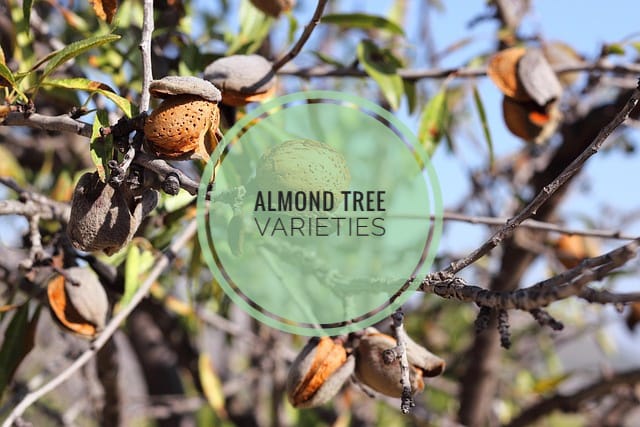Many of us search for ways to grow plants that are both useful and beautiful. If you landed here, you probably want to know how to grow, care for and enjoy the almond tree in India.
This guide will give you everything from history to growing conditions, varieties of almonds and benefits in simple language.
Introduction
The almond tree is one of the most valued nut-bearing trees like walnut and other nuts . It is admired for beauty, nutrition, and cultural importance in India.
Here’s a quick overview of its features:
| Feature | Description |
| Botanical Name | Prunus dulcis |
| Common Name | Almond tree |
| Family | Rosaceae |
| Origin | Middle East and South Asia |
| Type | Deciduous fruit tree |
| Average Height | 4 to 10 meters depending on variety and care |
| Lifespan | 30 to 50 years with good management |
| Climate Requirement | Temperate climate with mild summers and cool winters |
| Flowering Season | Late winter to early spring |
| Harvest Time | Mid-summer to early autumn depending on the region |
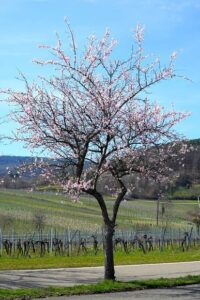
History and Origin
The almond tree has deep roots in history. It is native to the Middle East, especially regions of Iran and Afghanistan.
From there, it spread to India through ancient trade routes. Almonds became a treasured dry fruit, especially in northern states.
The word almond comes from the old French “almande” and Latin “amygdala.” It reflects its long cultural journey.
In India, almonds hold symbolic value in weddings, festivals, and traditional medicine. In Kashmir, almonds are part of daily life.
Growing Conditions
To grow an almond tree in India successfully, we need to understand its needs.
- Soil: Almonds prefer well-drained sandy loam soil. Avoid heavy clay soils. pH should be between 6 and 7.5.
- Sunlight: Full sunlight is necessary for healthy growth and fruiting. At least 6–8 hours daily.
- Water: Regular but moderate watering. Young plants need weekly watering. Mature trees need deep watering during fruiting.
- Temperature: Ideal range is 15°C to 30°C. They need a cool winter to flower properly. Extreme heat can damage flowers.
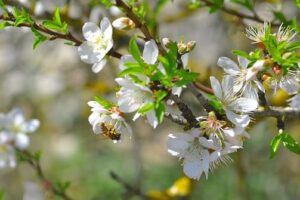
VARIETIES OF ALMONDS IN INDIA
Almond lovers in India have access to both locally grown varieties and imported types from California, Iran, Afghanistan, and Spain. Each variety has its own taste, size, oil content, and nutritional profile.
1. Mamra Almonds (Kashmir, Iran, Afghanistan)
- Rich in oil and nutrients, often regarded as the healthiest almonds.
- Grown in the cold valleys of Kashmir and imported from Iran.
- Small in size, irregular in shape, but prized for their strong flavor and high energy value.
2. Kashmiri Almonds (India)
- Locally cultivated in Kashmir, smaller in size compared to California almonds.
- Rich in oil and have a more intense aroma.
- Valued in traditional Indian households and often used in sweets.
3. Gurbandi Almonds (Afghanistan)
- Also called “Choti Giri,” these are smaller but packed with antioxidants, omega-3, and vitamin E.
- Known for their slightly bitter taste due to high oil content.
4. California Almonds (USA)
- The most widely available variety in Indian markets.
- Smooth, uniform, and larger in size compared to Kashmiri almonds.
- Popular for snacking, baking, and making almond milk.
5. Nonpareil Almonds (USA)
- A leading California variety, known for thin shells and sweet taste.
- Easily blanched and widely used in confectionery and bakery products.
6. Carmel Almonds (USA)
- Flat in shape, light brown skin, and good blanching quality.
- Often used as a pollinator for other almond types but also enjoyed raw.
7. Marcona Almonds (Spain)
- Short, round, and buttery with a sweeter flavor.
- Premium variety often used in Mediterranean desserts and luxury gift boxes in India.
8. Sonora Almonds (USA)
- Long and narrow kernels with thin skin.
- Excellent for making almond-based drinks and garnishing desserts.

TABLE OF POPULAR ALMONDS
| Variety | Origin / Where Grown | Distinctive Features / Use | Approx Price per kg (₹) |
|---|---|---|---|
| Mamra Almonds | Kashmir; imported varieties from Iran, Afghanistan | Very high oil content; strong flavor; premium quality; used in desserts, gifting | ₹2,800‒₹3,500 (GGT) |
| Kashmiri Almonds | Kashmir region, India | Smaller size; aromatic taste; used in sweets; lower cost than premium Mamra | ₹1,600‒₹2,200 (Kashmir Store) |
| Gurbandi Almonds | Afghanistan / imported | Small, rich in antioxidants; slightly bitter; dense texture | ₹1,500‒₹2,000 (estimation based on similar imported premium types) |
| California Almonds | USA origin, widely available in India | Uniform kernels, milder taste; used for snacking, baking, almond milk | ₹1,200‒₹1,700 (Exporters India) |
| Nonpareil Almonds | California, USA | Thin shell; light colored; excellent for baking and confectionery | ~ ₹1,500‒₹1,900 (premium grade) |
| Carmel Almonds | USA | Good for blanched almonds; medium-sweet; flatter shape | ₹1,400‒₹1,800 |
| Marcona Almonds | Spain | Short, round; buttery texture; often premium and gourmet | ₹2,000‒₹2,500 (imported, gourmet segment) |
| Sonora Almonds | USA | Long, narrow; thin skin; good for raw eating or drinks | ₹1,300‒₹1,700 |
- “Mamra” almonds are much pricier because of scarcity, high oil content, traditional hand-picking, and premium import charges. (GGT)
- Prices for California and commonly imported almonds fluctuate depending on import duties, shipping, and currency rates. Retail packs often cost more per kg than wholesale or bulk orders. (Exporters India)
- Local “normal” almonds (non-premium grades) might go for ~ ₹1,000 per kg in many mandi/wholesale markets. (commodityonline.com)
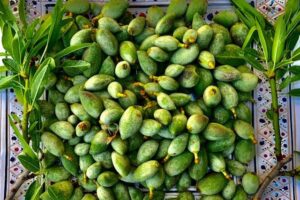
INDIAN “DESHI BADAM” VS TRUE ALMOND
When we talk about almonds in India, it is important to clear a common confusion. In states like Maharashtra, southern parts people often refer to a tree called deshi badam as almond. This tree, scientifically known as Terminalia catappa, is also called the Indian almond or tropical almond.
They taste different, have lower oil content and are rarely used in large-scale cooking or trade.
So when we enjoy almonds at home, in sweets or as dry fruits, we are actually eating true almonds from temperate regions, not the deshi badam seen in Maharashtra and other tropical areas.
main states where it grows naturally-
Maharashtra – Commonly planted in villages, towns, and home gardens as shade trees.
Tamil Nadu & Kerala – Grown along coastal belts, roadsides, and temple areas.
Andhra Pradesh & Telangana – Often seen in dry regions because of its hardy nature.
West Bengal & Odisha – Planted near coastal areas and in parks.
Goa & Karnataka – Popular as an ornamental tree along beaches and urban landscapes.
It grows well in tropical climates, tolerates heat, and is often planted for shade, ornamental value, and sometimes for its edible seeds. However, it is not cultivated commercially like true almonds (Prunus dulcis) in Kashmir or Himachal.

Care Tips
Caring for the almond tree is essential for healthy fruiting.
- Pruning: Prune young trees to develop a strong frame. Remove dry or diseased branches regularly.
- Fertilizing: Apply well-rotted manure during winter. Use nitrogen-rich fertilizer in the growing season.
- Repotting (for potted almonds): Repot young trees every 2–3 years. Ensure soil is refreshed.
- Propagation: Usually grown from grafted plants. Seeds can be used but may not produce quality nuts.
- Mulching: Apply organic mulch around the base to retain soil moisture.
Common Problems and Solutions
- Pests – Aphids and borers
Solution: Spray neem oil or mild organic insecticides. - Fungal diseases – Leaf spot and rust
Solution: Ensure proper air circulation. Use copper-based fungicides. - Fruit drop
Solution: Avoid over-watering. Provide balanced nutrition. - Frost damage
Solution: Choose late-blooming varieties like Makhdoom to escape frost harm. - Poor yield
Solution: Ensure cross-pollination by planting compatible varieties nearby.
Uses and Benefits
The almond tree in India is not only about nuts. It has multiple uses and benefits:
- Nutritional Value: Almonds are rich in protein, vitamins, and minerals.
- Medicinal Uses: Almond oil is used for skin, hair, and digestion in Ayurveda.
- Environmental Role: Provides shade, greenery, and improves soil fertility.
- Economic Value: Almond farming supports rural economy, especially in Kashmir.
- Cultural Importance: Offered during festivals, marriages, and as gifts.
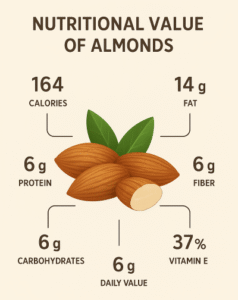
Interesting Facts
- Almonds are related to peaches and apricots.
- The tree blossoms before leaves appear, making it look magical.
- India imports large quantities of almonds despite domestic production.
- One mature tree can produce 15–30 kilograms of almonds annually.
- Almonds are among the earliest domesticated fruit trees in history.
FAQs📦 Frequently Asked Questions 1. Can almond trees grow in all parts of India? 2. How long does it take for an almond tree to bear fruits? 3. Do almond trees need cross-pollination? 4. Which are the most suitable varieties of almonds for India? 5. Are bitter almonds safe to eat? |

Conclusion
The almond tree in India is more than just a fruit tree. It is a source of nutrition, culture, and beauty. With the right care, even small gardeners can enjoy its rewards.
Growing an almond tree may take patience, but the joy of harvesting your own almonds makes it worth it.
Thanks for reading. Keep growing, keep exploring, and don’t forget to return here at gardeningbud.com for more plants, tips and gardening wisdom.
